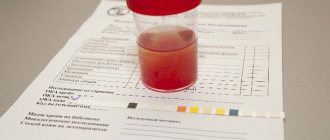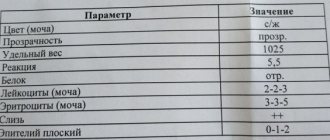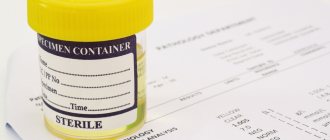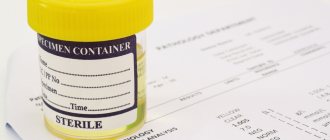Preparation
Special preparation for urine collection for urine analysis according to Zimnitsky is not required.
You must first agree with your doctor about stopping diuretics (diuretics) on the day of urine collection.
The patient should record the amount of all fluids consumed on the day of urine collection (water, tea, coffee, juices, soups, and intravenous drips) and provide this data to their doctor along with the test results.
You must first obtain 8 sterile containers from the laboratory or purchase them at the pharmacy. Also at the pharmacy you need to purchase a container for collecting urine with graduation to determine the volume of each portion of urine.
Urine collection procedure:
Urine is collected throughout the day.
At 6 o'clock in the morning, empty your bladder, pour this portion of urine into the toilet, its volume is not recorded.
Over the next 24 hours, 8 portions of urine are collected every 3 hours (until 6 o'clock the next morning).
- 1st portion - from 06:00 to 09:00
- 2nd portion - from 09:00 to 12:00
- 3rd portion - from 12:00 to 15:00
- 4th serving - from 15:00 to 18:00
- 5th portion - from 18:00 to 21:00
- 6th portion - from 21:00 to 24:00
- 7th portion - from 24:00 to 03:00
- 8th portion - from 03:00 to 06:00
Urine collection is carried out in a dry, clean, graduated container.
After each urination, it is necessary to record the volume of the collected portion (for example, 256 ml).
Then the urine in the container needs to be mixed and some (about 60 ml) poured into one sterile container, the remaining urine should be poured out.
On the container write the volume of the entire portion and the time of collection of this portion.
Close the container tightly with a lid and store in the refrigerator at a temperature of +2...+8°C.
Thus, you need to collect 8 portions of urine per day.
The next morning, deliver all portions to the laboratory.
IMPORTANT! If you did not urinate during a certain period of urine collection (for example, from 15.00 to 18.00 hours), then an empty container must be delivered to the laboratory. On the empty container, indicate the time interval and serving volume - “0 ml”.
There is no need to get up specifically at night to urinate if there is no urge to urinate.
Preparation and delivery of the Zimnitsky sample
In order for the analysis to be truthful and informative, the patient needs to start preparing the day before urine collection: stop using diuretics, exclude carrots and beets from the diet (they can change the color of urine), and also do not eat spicy foods. The amount of water you drink per day should not exceed two liters. Before each urine collection, genital hygiene procedures should be carried out to prevent the introduction of microbes into the sample.
To collect the test material, you need to prepare eight sterile jars (you can buy special containers at the pharmacy). Each container is numbered and the time is signed: 1 is 9.00, 2 is 12.00 and so on in three hour increments. At 6.00 the patient must void into the toilet, and from 9.00 begin collecting urine in jars; samples must be stored in the refrigerator.
If at a certain time the subject does not want to go to the toilet, then the signed container is left empty. The next morning, all containers must be delivered to the laboratory, where they will conduct a study of the daily sample according to Zimnitsky.
Interpretation of the result
At the medical office, you can get personal advice from a doctor from the “Doctor Q” service on interpreting the results of the study during your appointment or by phone.
It must be remembered that interpretation of the results of a urine test according to Zimnitsky should only be carried out by a doctor, since the results of laboratory tests are not the only criterion for making a diagnosis and prescribing appropriate treatment. They should be considered in conjunction with medical history and the results of other possible examinations, including instrumental diagnostic methods.
An adult normally excretes approximately 67–75% of the liquid he drinks during the day. Daytime diuresis should exceed nighttime and amount to 2/3–3/4 of the total amount of daily urine. The relative density during the day ranges from 1.005 to 1.025 g/ml.
If night diuresis predominates over daytime diuresis, then this indicates a decrease in the concentrating ability of the kidneys. Nocturnal predominance of diuresis is often found in diabetes insipidus and heart failure.
An excess of urine density above 1.025 g/ml is observed in cases of dehydration, pyelonephritis, and uric acid diathesis in children.
A decrease in urine density below 1.005 g/ml indicates a decrease in the concentration function of the kidneys and occurs in renal failure, chronic glomerulonephritis and pyelonephritis, diabetes insipidus and diabetes mellitus, hyperaldosteronism, while taking diuretics, severe potassium deficiency, excess calcium,
To confirm the resulting pathological abnormalities, the doctor may prescribe stress tests to the patient to dilute and concentrate urine.
Why do the Zimnitsky test?
Urinalysis according to Zimnitsky helps the doctor make the correct diagnosis and select effective treatment. The study allows you to obtain accurate information not only about the volume of urine produced, but also about the salt content in it.
Indicators that are checked during analysis:
- Daily diuresis is the amount of urine excreted in 24 hours.
- The ratio of the amount of liquid drunk to the volume of urine excreted.
- Daytime diuresis.
- The amount of fluid excreted per night (nocturnal diuresis).
- Urine density.
Typically, the Zimnitsky test is prescribed to patients suffering from heart failure, diabetes mellitus, chronic pyelonephritis, hypertension, and also to pregnant women if systematic swelling of the limbs is diagnosed.
Urine volume
A healthy person normally excretes approximately 3/4 (65–80%) of the liquid they drink during the day.
Polyuria
– excretion of more than 2000 ml of urine per day, the reasons may be:
- hyaline (with overlay of erythrocytes, leukocytes, renal epithelial cells, amorphous granular masses);
- granular;
- waxy;
- pigmented;
- epithelial;
- erythrocyte;
- leukocyte;
- fatty.
Oliguria
– excretion of less than 400 ml of urine per day, the reasons may be:
- limiting fluid intake;
- increased fluid loss (increased sweating, profuse diarrhea, uncontrollable vomiting);
- edema of various origins (heart failure, renal dysfunction).
Anuria
– 200–300 ml or less urine per day or complete cessation of urine output, the reasons may be:
- secretory anuria:
- impairment of glomerular filtration (shock, acute blood loss, uremia).
- excretory anuria:
- violation of urine separation through the urethra;
- bladder dysfunction.
Reminder for collecting urine tests
Technique for collecting urine for general analysis
After toileting the external genitalia, morning urine is collected for general analysis in a disposable pharmaceutical container of at least 50 ml.
The urine container must be delivered to the laboratory between 7:30 and 10 am.
Technique for collecting urine analysis “according to Nechiporenko”
After toileting the external genitalia, collect an AVERAGE portion of morning urine with a volume of at least 20 ml. The first and last portions of urine are poured into the toilet into a disposable pharmaceutical container.
The urine container must be delivered to the laboratory between 7:30 and 10 am.
Technique for collecting daily urine
Urine is collected over 24 hours. In the morning before urine collection
toilet the external genitalia. The first portion of urine in the morning is released into the toilet and the time of urination is noted. Next, all urine during the day (until the same time the next day) should be collected in one container (usually a 3-liter jar with a lid is used, which is stored in the refrigerator).
After collecting the material, you must independently assess the total volume of urine collected. After which the urine is mixed and part of it (at least 100 ml) is poured into a special container. It is this container that is delivered to the laboratory (the entire volume of urine does not need to be delivered) from 7-30 to 10 am.
When submitting urine to the laboratory, it is necessary to indicate from what time to what time the urine was collected; what is the total volume of urine?
It is allowed to collect urine up to 12 hours in advance.
Technique for collecting urine for bacteriological culture
Prepare a sterile container for collecting urine. Wash your hands with soap, then thoroughly wash your external genitalia.
- after washing, take a sterile container to collect urine, open the lid so as not to touch the inner surface of the lid and container;
- release the first stream of urine into the toilet, hold urination, place a container, release urine into the container in an amount of at least 10 - 15 ml, flush the remaining portion of urine into the toilet. Carefully close the lid of the container without touching the edges of the neck.
Hypothermia, overheating and spilling urine are not allowed!
Analysis is accepted strictly from 7:30 to 8:45 (except weekends)
Technique for collecting urine for glucosuric profile
Daily urine is collected in three clean separate jars, and the time of urine collection is signed on each jar.
- from 6-00 to 14-00.
- from 14-00 to 22-00.
- from 22-00 to 6-00.
The amount of urine collected is measured in ml.
The amount of urine collected is measured. The amount is indicated in ml.
Urine is poured from each jar into a separate plastic container (at least 50 ml), and the time of urine collection is signed on each container.
Containers with urine must be delivered to the laboratory between 7:30 and 10 a.m. (except weekends).
Urine collection technique for the Rehberg test
The Rehberg test involves collecting urine and blood samples. The day before, exclude physical activity, alcoholic drinks, strong tea, spicy and fatty foods.
Urine is collected over 24 hours. In the morning, before collecting urine, toilet the external genitalia. The first portion of urine in the morning is released into the toilet and the time of urination is noted. Next, all urine during the day (until the same time the next day) should be collected in one container (usually a 3-liter jar with a lid is used, which is stored in the refrigerator).
After collecting the material, you must independently assess the total volume of urine collected. After which the urine is mixed and part of it (at least 150 ml) is poured into a special container. It is this container that is delivered to the laboratory (the entire volume of urine does not need to be delivered) from 7-30 to 10 am.
When submitting urine to the laboratory, it is necessary to indicate from what time to what time the urine was collected and the total volume of urine. Indicate your height, weight and amount of liquid drunk during the day.
When delivering a urine test to the laboratory, it is necessary to donate blood on that day to determine the level of creatinine (fasting)
Urine collection technique according to Zimnitsky
During the study, daily, daytime and nighttime diuresis and the relative density of urine in each of the 3-hour portions are determined.
Urine collection for the Zimnitsky test is carried out at certain hours during the day. The test is carried out with normal drinking and nutrition.
In order to correctly collect the required material you need:
- 8 clean containers with a lid, each holding a volume of 200 ml - these can be obtained from the hospital laboratory (label the time of urine collection on each)
- A watch, preferably with an alarm (urine collection should occur at certain hours)
- A notepad for recording the liquid consumed during the day (including the volume of liquid received with soup, milk, etc.)
How to collect urine for research according to Zimnitsky?
At 6 o'clock in the morning you need to empty your bladder into the toilet. Throughout the day, every 3 hours you need to empty your bladder into jars (if one container is not enough, take an additional container)
Strictly observe a 3-hour gap between urine portions!
- from 6 to 9 am - collect all urine excreted over the next 3 hours into the first container;
- from 09 to 12 o'clock - to the second container;
- from 12 to 15 o'clock - on the third;
- from 15 to 18 hours - on the fourth;
- 18 to 21 o'clock - at five;
- from 21 to 24 o'clock - at six;
- from 24 to 03 o’clock – at seven o’clock;
- from 03 to 06 a.m. fill the last, eighth container.
Jars to be filled must be kept cool and closed (in the refrigerator). The next morning, you must take all the jars with their contents to the laboratory, additionally providing records of the liquid consumed during the day.
Indications for prescribing the Zimnitsky test
This study is prescribed in the following cases:
- for the primary diagnosis of diseases of the urinary tract, cardiovascular system, pancreas and other organs;
- when the color of the urine changes (cloudy, too concentrated or clear);
- for control of chronic diseases (glomerulonephritis, pyelonephritis, diabetes mellitus and diabetes insipidus, renal, liver and heart failure, hypertension, etc.);
- if you complain of aching pain in the lumbar region, difficulty urinating, swelling, etc.;
- if the general urinalysis has pronounced deviations.
The study may also be recommended for patients taking diuretics for a long time, receiving parenteral nutrition, who have recently undergone an X-ray examination of the urinary system with contrast, and in some other cases. If urine collection and analysis are performed correctly, the doctor receives complete information about the functioning of the kidneys, the state of their filtration and excretory functions.
What does a urine test according to Zimnitsky show?
The laboratory technician must carefully analyze each portion of urine and compare it with standard values.
Norm:
- More urine is produced during the day than at night.
- The specific gravity (density) of each portion should be in the range of 1.013 – 1.035.
- Daily diuresis is no more than 2000 ml, of which night time is about 500-650 ml.
- Within 24 hours, approximately 60-80% of the volume of liquid drunk should be eliminated from the body.
Standards may differ depending on the category of patients: children, adults, pregnant women. If deviations of the results from the norm are diagnosed, this indicates the development of pathologies in the urinary system. Of course, it is impossible to make an accurate diagnosis based on Zimnitsky’s test alone, but it is quite possible to find a direction to determine the disease.
Deviations in analysis results may indicate the following conditions:
Hypoisosthenuria – specific gravity below 1.013. Usually observed in renal failure due to the fact that the reabsorption of primary urine in the tubules almost does not occur. Such results can also be diagnosed in patients with chronic pyelonephritis, diabetes insipidus, heart failure, and glomerulonephritis.
Hyperisosthenuria – density above 1.035. This may be a sign of abnormalities of the hematopoietic organs, diabetes mellitus or gestosis in pregnant women.
Oligouria – less than 1500 ml of urine was excreted per day. The reasons for the formation of such a deviation include pyelonephritis, renal failure, increased sweating, etc.
Nocturia – more urine is produced at night than during the day. Diagnosed with kidney pathologies, liver cirrhosis, diabetes insipidus.
Polyuria is a daily diuresis of more than 2000 ml. It happens with diabetes mellitus, pyelonephritis, and also while taking diuretics.
If a urine analysis according to Zimnitsky reveals deviations from the norm, additional diagnostic procedures are necessarily prescribed to help clarify the diagnosis.
You can take a urine test according to Zimnitsky and get a transcript at the President-Med medical centers in Vidnoye and in Moscow (metro Kolomenskaya and metro VDNKh)







